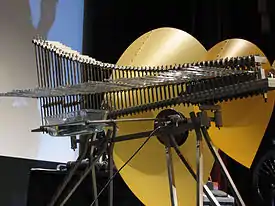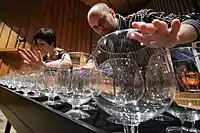Crystallophone
A crystallophone is a musical instrument that produces sound from glass.



One of the best known crystallophones is the glass harmonica, a set of rotating glass bowls which produce eerie, clear tones when rubbed with a wet finger. Musical glasses, the glass harp, were documented in Persia in the 14th century.[1] The "ethereal" quality of instruments such as the glass harmonica exemplified the Empfindsamkeit and for a while, "the instrument was extraordinarily popular...[but] About 1830 the instrument fell into oblivion."[1]
The glasschord (or glasscord) resembles the celesta (a struck plaque idiophone operated by a keyboard) but uses keyboard-driven hammers to strike glass bars instead of metal bars.
The glass marimba is similar to the marimba (a stick percussion instrument with a keyboard layout), but has bars of glass instead of wood. The bars, which the performer strikes with padded sticks, are perched on a glass box to provide the necessary resonance.
A rare Thai instrument called ranat kaeo (ระนาดแก้ว; literally "glass xylophone") has been used by the Thai music ensemble Fong Naam; it appears on their 1992 CD The Sleeping Angel: Thai Classical Music.
In popular culture
In Lydia Syson's biography, Doctor of Love: James Graham and his Celestial Bed (ISBN 9781846880544), sexologist James Graham uses the glass harmonica for musical therapy purposes.
Benjamin Franklin was inspired to create his glass harmonica in 1763 after attending a recital performed on musical glasses in London in 1761.[1]
See also
References
- Apel, Willi (1969). Harvard Dictionary of Music, p.347. Harvard. ISBN 9780674375017.
External links
| Wikimedia Commons has media related to Crystallophones. |
- Glass Music
- Oddmusic A website dedicated to unique, odd, ethnic, experimental and unusual musical instruments and resources.

